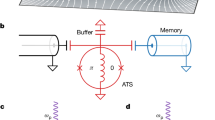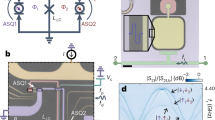Abstract
Pulsed magnetic resonance allows the quantum state of electronic and nuclear spins to be controlled on the timescale of nanoseconds and microseconds respectively1. The time required to flip dilute spins is orders of magnitude shorter than their coherence times2,3,4,5,6,7,8,9, leading to several schemes for quantum information processing with spin qubits10,11,12,13. Instead, we investigate ‘hybrid nuclear–electronic’ qubits14,15 consisting of near 50:50 superpositions of the electronic and nuclear spin states. Using bismuth-doped silicon, we demonstrate quantum control over these states in 32 ns, which is orders of magnitude faster than previous experiments using pure nuclear states2,3. The coherence times of up to 4 ms are five orders of magnitude longer than the manipulation times, and are limited only by naturally occurring 29Si nuclear spin impurities. We find a quantitative agreement between our experiments and an analytical theory for the resonance positions, as well as their relative intensities and Rabi oscillation frequencies. These results bring spins in a solid material a step closer to research on ion-trap qubits10.
This is a preview of subscription content, access via your institution
Access options
Subscribe to this journal
Receive 12 print issues and online access
$259.00 per year
only $21.58 per issue
Buy this article
- Purchase on Springer Link
- Instant access to full article PDF
Prices may be subject to local taxes which are calculated during checkout



Similar content being viewed by others
References
Schweiger, A. & Jeschke, G. Principles of Pulse Electron Paramagnetic Resonance (Oxford Univ. Press, 2001).
Morley, G. W. et al. The initialization and manipulation of quantum information stored in silicon by bismuth dopants. Nature Mater. 9, 725–729 (2010).
George, R. E. et al. Electron spin coherence and electron nuclear double resonance of Bi donors in natural Si. Phys. Rev. Lett. 105, 067601 (2010).
Tyryshkin, A. M. et al. Electron spin coherence exceeding seconds in high-purity silicon. Nature Mater. 11, 143–147 (2012).
Morton, J. J. L. et al. Solid-state quantum memory using the P-31 nuclear spin. Nature 455, 1085–1088 (2008).
Balasubramanian, G. et al. Ultralong spin coherence time in isotopically engineered diamond. Nature Mater. 8, 383–387 (2009).
Steger, M. et al. Quantum information storage for over 180 s using donor spins in a 28Si semiconductor vacuum. Science 336, 1280–1283 (2012).
Maurer, P. C. et al. Room-temperature quantum bit memory exceeding one second. Science 336, 1283–1286 (2012).
Weis, C. D. et al. Electrical activation and electron spin resonance measurements of implanted bismuth in isotopically enriched silicon-28. Appl. Phys. Lett. 100, 172104 (2012).
Ladd, T. D. et al. Quantum computers. Nature 464, 45–53 (2010).
Morton, J. J. L., McCamey, D. R., Eriksson, M. A. & Lyon, S. A. Embracing the quantum limit in silicon computing. Nature 479, 345–353 (2011).
Stoneham, A. M., Fisher, A. J. & Greenland, P. T. Optically driven silicon-based quantum gates with potential for high-temperature operation. J. Phys. Condens. Matter 15, L447–L451 (2003).
Koenraad, P. M. & Flatté, M. E. Single dopants in semiconductors. Nature Mater. 10, 91–100 (2011).
Mohammady, M. H., Morley, G. W., Nazir, A. & Monteiro, T. S. Analysis of quantum coherence in bismuth-doped silicon: A system of strongly coupled spin qubits. Phys. Rev. B 85, 094404 (2012).
Mohammady, M. H., Morley, G. W. & Monteiro, T. S. Bismuth qubits in silicon: The role of EPR cancellation resonances. Phys. Rev. Lett. 105, 067602 (2010).
Morello, A. et al. Single-shot readout of an electron spin in silicon. Nature 467, 687–691 (2010).
Takahashi, S. et al. Decoherence in crystals of quantum molecular magnets. Nature 476, 76–79 (2011).
Makhonin, M. N. et al. Fast control of nuclear spin polarization in an optically pumped single quantum dot. Nature Mater. 10, 844–848 (2011).
Maune, B. M. et al. Coherent singlet-triplet oscillations in a silicon-based double quantum dot. Nature 481, 344–347 (2012).
Belli, M., Fanciulli, M. & Abrosimov, N. V. Pulse electron spin resonance investigation of bismuth-doped silicon: Relaxation and electron spin echo envelope modulation. Phys. Rev. B 83, 235204 (2011).
Sekiguchi, T. et al. Hyperfine structure and nuclear hyperpolarization observed in the bound exciton luminescence of Bi donors in natural Si. Phys. Rev. Lett. 104, 137402 (2010).
Feher, G. Electron spin resonance experiments on donors in silicon. I. Electronic structure of donors by the electron nuclear double resonance technique. Phys. Rev. 114, 1219–1244 (1959).
Castner, T. G. Raman spin-lattice relaxation of shallow donors in silicon. Phys. Rev. 130, 58–75 (1963).
Du, J. et al. Preserving electron spin coherence in solids by optimal dynamical decoupling. Nature 461, 1265–1268 (2009).
Yang, W. & Liu, R. B. Quantum many-body theory of qubit decoherence in a finite-size spin bath. Phys. Rev. B 78, 085315 (2008).
Rønnow, H. M. et al. Quantum phase transition of a magnet in a spin bath. Science 308, 389–392 (2005).
Willer, M. et al. S-band (2–4 GHz) pulse electron paramagnetic resonance spectrometer: Construction, probe head design, and performance. Rev. Scient. Instrum. 71, 2807–2817 (2000).
Lenahan, P. M. & Conley, J. F. What can electron paramagnetic resonance tell us about the Si/SiO2 system? J. Vac. Sci. Technol. B 16, 2134–2153 (1998).
Morishita, H. et al. Electrical detection and magnetic-field control of spin states in phosphorus-doped silicon. Phys. Rev. B 80, 205206 (2009).
Mitrikas, G., Sanakis, Y. & Papavassiliou, G. Ultrafast control of nuclear spins using only microwave pulses: Towards switchable solid-state quantum gates. Phys. Rev. A 81, 020305 (2010).
Acknowledgements
We acknowledge Bernard Pajot for the Si:Bi crystal used here, R. Tschaggelar for technical assistance, the National EPR Facility and Service at the University of Manchester, UK, for initial continuous-wave experiments at 4 GHz and the EPSRC COMPASSS grant. Sandia National Laboratories is a multiprogram laboratory operated by Sandia Corporation, a wholly owned subsidiary of Lockheed Martin Corporation, for the US Department of Energy’s National Nuclear Security Administration under contract DE-AC04-94AL85000. G.W.M. is supported by the Royal Commission for the Exhibition of 1851 and the Royal Society.
Author information
Authors and Affiliations
Contributions
G.W.M. and T.S.M. designed the study within the overall research programme on Si:Bi defined by C.W.M.K. and G.A., and wrote the paper with input and corrections from all authors. P.L. performed the experiments with assistance from G.W.M. and M.H.M., and supervision from G.J. G.W.M. analysed the data. S.J.B. and W.M.W. performed the cluster correlation expansion simulations.
Corresponding author
Ethics declarations
Competing interests
The authors declare no competing financial interests.
Supplementary information
Supplementary Information
Supplementary Information (PDF 926 kb)
Rights and permissions
About this article
Cite this article
Morley, G., Lueders, P., Hamed Mohammady, M. et al. Quantum control of hybrid nuclear–electronic qubits. Nature Mater 12, 103–107 (2013). https://doi.org/10.1038/nmat3499
Received:
Accepted:
Published:
Issue Date:
DOI: https://doi.org/10.1038/nmat3499
This article is cited by
-
Quintet formation, exchange fluctuations, and the role of stochastic resonance in singlet fission
Communications Physics (2023)
-
First-principles theory of extending the spin qubit coherence time in hexagonal boron nitride
npj 2D Materials and Applications (2022)
-
The multi-photon induced Fano effect
Nature Communications (2021)
-
Parallel-Mode EPR of Atomic Hydrogen Encapsulated in POSS Cages
Applied Magnetic Resonance (2020)
-
Electrically controlled nuclear polarization of individual atoms
Nature Nanotechnology (2018)



